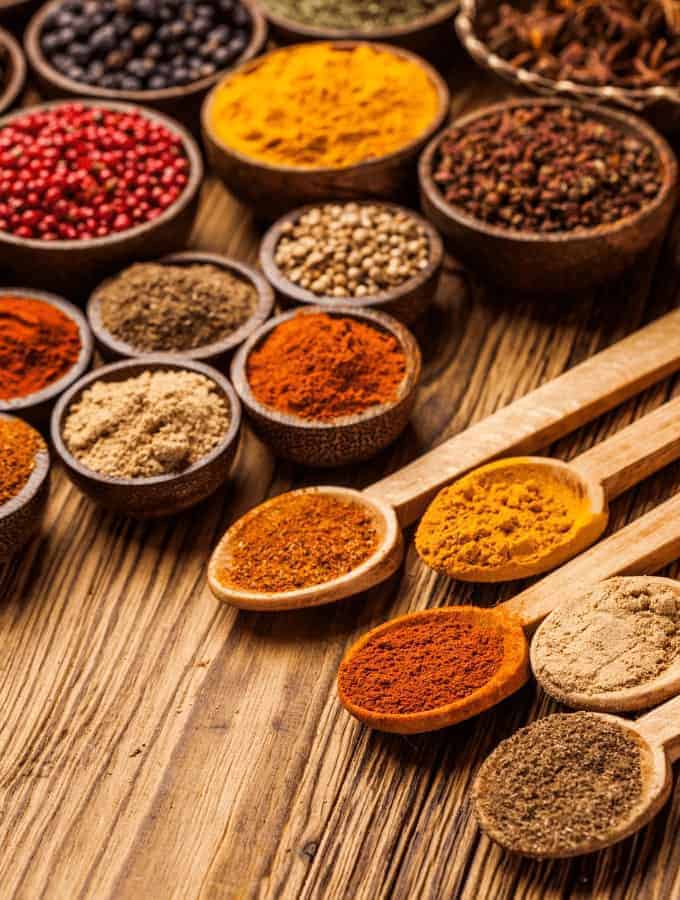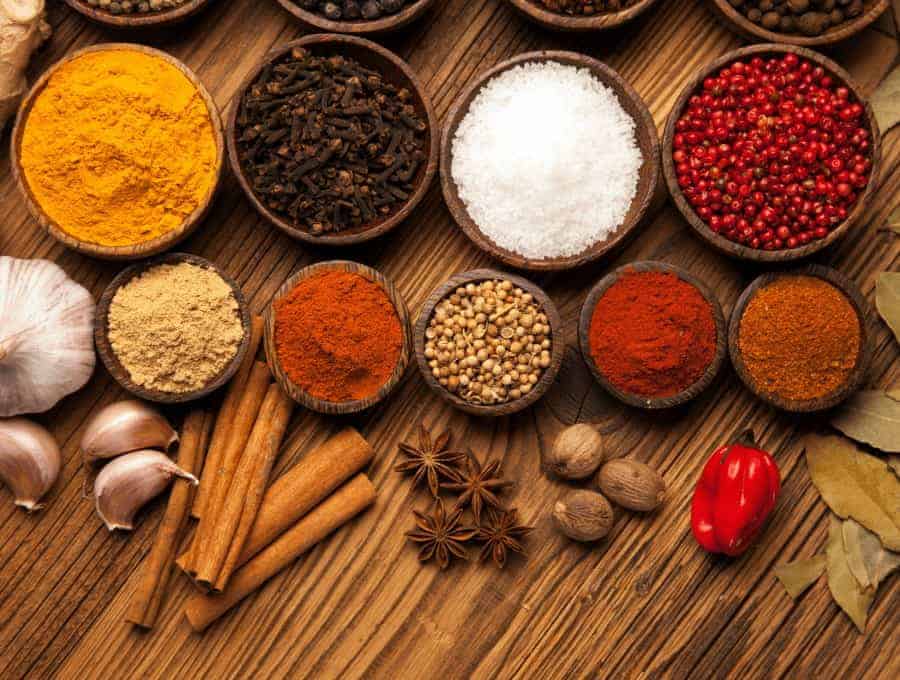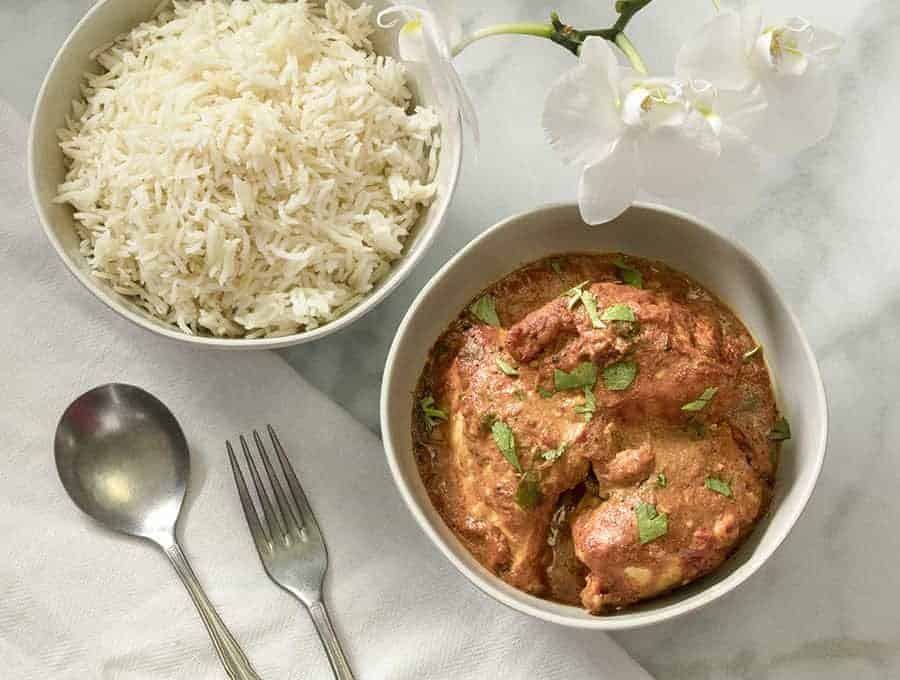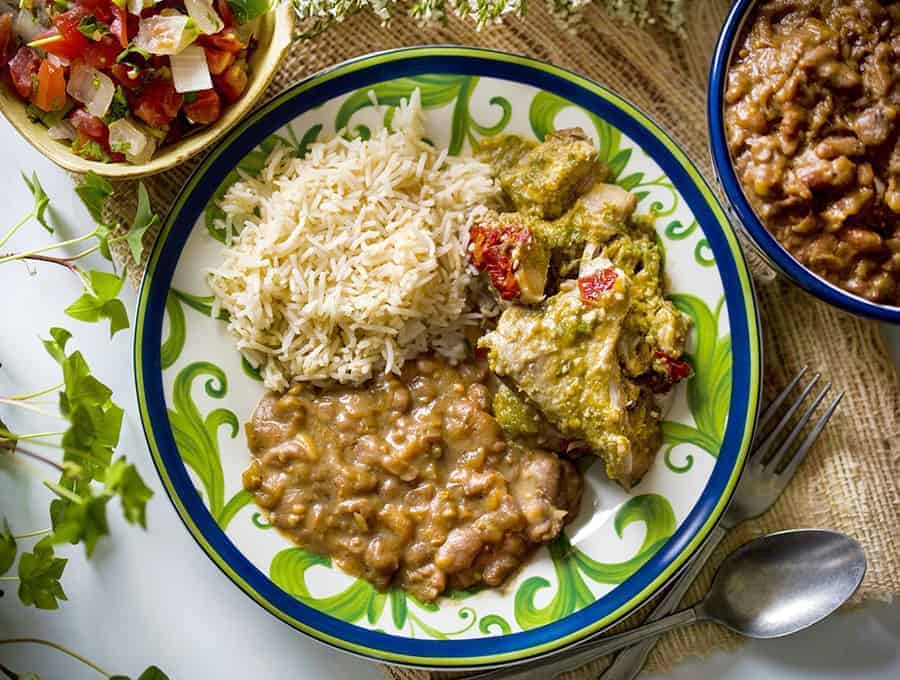Using the right spices and using fresh spices in your cooking will elevate your cooking. This is true of Indian Cooking, but really, I will show you how I think it's true of every type of cuisine.
I would strongly urge you to watch the video in this post. I have attempted to transcribe much of the content into this post, but the video is the best way to get all the good nuggets of information.
The spices I'll be covering in this post will mostly focus on Indian cooking. However, I'm going to discuss how cooking with spices can open up many more possibilities and ideas for your cooking in general.
If you're wanting to branch out from traditional American spices and cooking, then this is a great place to start!
Use all of the Spices!
I have to tell you, it was quite a shock when I first came to this country and realized there were some people who had only cooked with salt and pepper.
I grew up in a country where spices were plentiful and grown everywhere. Indian spices can be rather intimidating however, they can be quite fun as well.
They are honestly, the best part about Indian cooking. I can't wait to talk to you about how to make your food flavorful with a whole new world of spices, so let's get talking.
Cooking With Spices
There are so many Indian spices that it can be overwhelming. That's what I'm here to clarify for you.
I'm going to show you how to use these spices in a way that will make you confident utilizing Indian spices in general.
As long as you follow my directions, buy the specific spices I'm telling you to buy, and use them in the way I'm telling you to use them, you will have great success in using Indian spices to make all types of cuisines.
Want to get an my entire presentation on this subject? Go download and print it for free HERE!
Using Spices in a Variety of Ways
What I'll be covering in this article and in the accompanying video, are the different ways to use Indian spices.
Further, I'll be sharing which spices you really need and what else you can use them for.
I'm going to start with the various ways you can use these spices. You may be at the store and be very confused. You may have questions like, should I be buying fresh turmeric, or should I be buying dry turmeric?
Should I be buying whole or ground cumin seeds? Am I buying this in a mixture? Am I buying garam masala already made or am I buying the spices to make it?
All of these can be overwhelming if you've not cooked with a lot of spices, especially Indian spices.
Even if you know what you're doing and come home from the store ready to go, you still have a whole set of decisions in front of you. Are you going to roast the spices with oil or dry roast them? Are you going to ground the spices or are you going to leave them whole? Are you going to use the spices alone or are you going to use them in combination with other spices? It can be quite a confusing task to use Indian spices, especially if you're not familiar with them.
Once you figure out what spices to use where and how to use them, this will be a lot less confusing for you.
Just to recap some things that I've told you before, you can buy the same spice fresh or dry. For example, you have the option to buy turmeric fresh or dry. Turmeric also comes whole, or you can buy it ground. Turmeric can even be used unroasted.
It can be dry roasted, oil roasted, it can be used alone, or it can be mixed with other spices. Here's what that tells you, that turmeric, for example, or cumin seeds, are not just turmeric and cumin seeds, they can be used in a plethora of ways and forms.
To Roast or Not To Roast?
I want to talk about this a little bit because it is very important in Indian cooking.
There's a few reasons why you may roast spices.
First, when you apply heat to certain spices, they release an oil that's very aromatic. You can even smell this oil as you're roasting as it can be a wonderful aroma!
Second, when you roast spices, you're removing the moisture which means they can be stored for longer periods of time. Once the moisture is removed, you can grind the spices and it won't turn into a paste, it will turn into a fine powder instead.
Lastly, you may roast spices with oil. You would roast the spices in that oil because the oil takes on the flavor that is being released from the spices as they're being roasted.
A great example of this is when you cook garlic in oil. The oil becomes laden with garlic flavor and becomes very aromatic.
The same is true when you roast cumin seeds in oil--not only do the seeds taste different, but the oil they were roasted in also takes on the flavor of those cumin seeds.
Ground Spices or Whole Spices?
In some of my recipes, I may tell you to use the same spice but in two different ways.
For example, I might tell you to use both whole cumin seeds and ground cumin.
This is because when you eat a spice whole, it can be a very concentrated flavor as you bite into that spice or seed. In contrast, a ground spice lends it flavor subtly to the whole dish, rather than in one concentrated bite.
The best tip I can give you for Indian spices is to buy them whole.
You can use them in a variety of ways, so beginning with the whole spice gives you more options for uses. However, the biggest reason why you buy Indian spices whole is because of the taste. When you buy spices already ground or pre-mixed, they don't have the same flavor, you don't always know what's in them, etc.
Just take the time to compare a store-bought spice to a whole fresh spice. In the smell alone, you'll be able to tell the difference.
I'm going to tell you all the spices that you really need. You don't have to write all these down, there is a PDF or a PowerPoint presentation available for you to download, for free, that has the list of these spices HERE and the video in this post covers this as well.
Turmeric and cayenne are the only two that I suggest you buy ground. The rest of the spices you need to buy whole.
Two spices with special exceptions to note: Cayenne and Cardamom
You need to know the differences between chili powder and cayenne. These are not one and the same. Typically, in the United States, chili powder is a blend of cayenne, cumin, and other spices. If a recipe calls for chili powder, do NOT use cayenne or you will light a fire in your mouth, the likes of which you will never forgive me for.
With cardamom, there are various types that you need to be aware of. The four cardamom types that are widely available are white, green, black, and whole cardamom seeds. White and green can be used interchangeably while the black one cannot.
It's important to note that you need to get cardamom in the pod and cardamom out of the pod (the seeds).
I want you to go into your pantry, right now, and get rid of all those random ground spices that have been in there for way too long. Then, I want you to go to one of those stores that allows you to get spices from the bins. Just get enough for one recipe. Try it out and see if you can tell the difference. Many people in my groups have stated that they can definitely tell a difference and I'm sure you will too.
What about Curry powder?
You may be sitting there thinking, "She's talking about Indian food and hasn't mentioned curry powder once!" There's a reason for that, and that's because we in India don't actually use curry powder. Curry powder is just a mixture of random Indian spices that's used, basically, as a cheater spice. Further, Curry is not a spice, it is actually any dish that's cooked with water. This would be like me saying that the United States has a soup powder. There is no such thing as curry powder.
Garam Masala
For my recipes, it's important that you make the garam masala spice exactly as I tell you to. If you end up making one of my recipes that calls for garam masala and tell me it turned out bland, I know that you did not make or use my garam masala as I told you to.
When you buy a store-bought garam masala powder, you have no idea what is actually going into it or how long ago it was made. This results in you getting, for example, a paprika chicken rather than a true garam masala chicken. There is no substitute for buying your own whole spices and making your own garam masala powder.
Storing Spices
With whole spices, you can keep them stored for a year. Once you begin grounding the spice, the shelf life shortens dramatically.
Once the spice is ground, you have about six to eight weeks to use it before you need to replace it. For ground spices that have been roasted in oil, they have a shelf life of about three to four weeks.
If you get the spices from the list that I gave, you'll be able to make a plethora of various ethnic dishes. For example, you'll be able to make my famous butter chicken. It's full of flavor, and uses my garam masala spice mix recipe:
You'll also be able to make these delicious refried beans, and you'll never buy canned again!
For those of you who are intimidated or have been overwhelmed by using spices, go to the store and get the spices that I listed off to you. If you do, before long, you will be confident with all of your Indian dishes, plus some. This is how you get over your fear of using Indian spices and you'll gain a sense for using them in any dish.





Leave a Reply